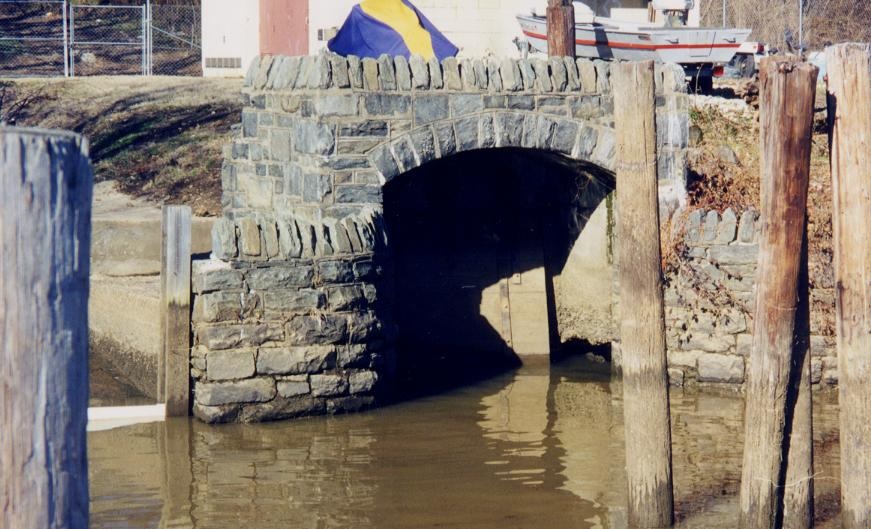DC Water operates a wastewater collection system comprised of "separate" and "combined" sewers. Approximately two-thirds of the District is served by a separate sewer system, while the remaining one-third is served by combined sewers. The District's combined sewer area and combined sewer overflow outfalls are illustrated in the interactive figure to the right under "What Sewershed are You in?"
What is a Combined Sewer Overflow or CSO?
A combined sewer system conveys both sanitary sewage and storm water in one piping system. The District's combined sewer system was developed before 1900. Separate systems are comprised of two independent piping systems: one system for "sanitary" sewage (i.e., sewage from homes and businesses) and one system for storm water. The figure below and following paragraphs illustrate and explain combined and separate sewer systems.
Combined and Separate Sewer Systems (click to enlarge)
Normal, Dry Weather Conditions
Separate Sewer System - Sanitary wastes are directed to the Blue Plains Advanced Wastewater Treatment Plant (Blue Plains). The separate storm sewer system is dry. Typically, there are no overflows to the District's rivers and creeks. The top left graphic in the figure above illustrates a separate sewer system in dry weather conditions.
Combined Sewer System - Sanitary wastes collected in the combined sewer system are diverted to Blue Plains at facilities called regulators or dams. Typically, there are no overflows to the District's rivers and creeks. The bottom left graphic in the figure above illustrates a combined sewer system in dry weather conditions.
Wet Weather (Rainy) Conditions
Separate Sewer Sytem - Sanitary wastes are directed to Blue Plains (same as dry weather conditions). Rainfall enters the separate sewer system via storm drains and is discharged to the District's rivers and streams. This is referred to as "stormwater" flow. The top right graphic in the figure above illustrates a separate sewer system during rainy conditions.
Combined Sewer System - During periods of rainfall, the capacity of a combined sewer may be exceeded. When this occurs, regulators are designed to let the excess flow, which is a mixture of stormwater and sanitary wastes, be discharged directly into the District's rivers and creeks. This excess flow is called combined sewer overflow or CSO. Release of this excess flow is necessary to prevent flooding in homes, basements, businesses, and streets. The bottom right graphic in the figure above illustrates a combined sewer system during rainy conditions.
CSO's are discharged to the Anacostia River, Rock Creek, Potomac River or tributary waters at CSO outfalls during most moderate rain events. There are a total of 48 potentially active CSO outfalls listed in the existing National Pollutant Discharge Elimination System permit from the United States Environmental Protection Agency. A typical CSO outfall is shown here:

Typical CSO Outfall
Why are CSO's a Concern?`
CSOs can adversely affect the quality of our receiving waters in the following ways:
- CSOs contain material which contributes to high bacteria levels in the receiving waters
- Organic material in CSOs can contribute to low dissolved oxygen levels, which can contribute to a potential for fish stress or fish kills, especially in summer months; and,
- Debris in CSOs such as plastic bottles, styrofoam cups (otherwise known as "floatables") contribute to poor aesthetics.
When do CSO's Occur?

CSOs should only occur during wet weather. Whether an overflow occurs and the magnitude of the overflow depends on many factors including rainfall volume, rainfall intensity, and recent rainfall in the area. CSOs typically overflow more in wet years than dry years and more intense rains also make it more likely that CSOs will occur.
DC Water has also posted signs at each CSO outfall. Look for these signs near outfalls.
Avoid Contact with Combined Sewer Overflows
DC Water is committed to improving the quality of water within the District of Columbia. Discharges may be dangerous to the public, due to the high flow of water that may exit these sewer outfalls. Potentially harmful substances may also be present in these discharges. The public is advised to stay away from any sewer pipe discharge.
For small rainfalls, the effects of CSOs typically last less than 24 hours. For larger rainfalls, greater than 1" of rain, the effects of CSOs on water quality can last up to three days. Please note that the District of Columbia Department of Health has imposed a ban on swimming in all rivers and creeks in the District of Columbia and any contact with rivers and creeks immediately downstream of any sewer pipe discharge should be avoided.
Warning Light System
DC Water has installed a series of CSO Event Indicator Lights to notify river users of CSO events. The Potomac River light is located on the north shore, near the mouth of Rock Creek. There are four CSO Event Indicator Lights installed along the Anacostia River, one each in the following locations:
- Main Pumping Station
- DC Water's Skimmer Boat Yard Facility
- Anacostia Community Boathouse
- CSO 019 Tunnel Overflow Structure (south of RFK Stadium)
A red light will be illuminated during a CSO occurrence and a yellow light will be illuminated for 24 hours after CSO has stopped. The Potomac River CSO Indicator Light is operated by a signal from CSO outfall #021 (Northeast of Roosevelt Bridge, NW). The Anacostia River CSO Event Indicator Lights are operated by tunnel overflow structure at CSO 019 just south of RFK Stadium.




